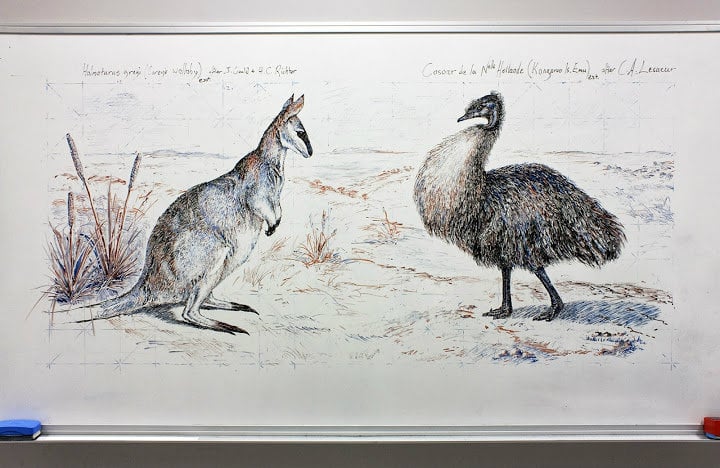In France, in 1822, the last surviving Australian dwarf emu died.
Two distinct dwarf emu sub species lived in splendid isolation on King Island and Kangaroo Island for thousands of years, developing variations, and growing to only half the height of their mainland cousins.[1] The arrival on the two islands of European sealers and farmers led to a rapid and terminal decline.
Several emus from both islands were collected during the French scientific expedition to Australia (1800-1804) led by Nicolas Baudin.
The expedition gathered a range of antipodean animals and birds, and a massive number of plants. Nicolas Baudin, like many of the captured animals, failed to complete the journey, dying in Mauritius on the voyage back to France.
The plants and the surviving animals were destined for the lonely imperial splendour of the French Empress Josephine’s estate, Malmaison[2]. Josephine had purchased Malmaison in 1799 when husband Napoleon Bonaparte was campaigning in Egypt.
For the rest of her life Josephine developed a magnificent garden including many plants from Baudin’s expedition[3]. Roaming the gardens were various exotic creatures. Josephine’s particular favourites were a pair of Australian black swans[4].

Title page, Voyage de découvertes aux terres australes Vol 3. Black swans, kangaroos and dwarf emus all frolic in the splendid gardens of Malmaison
Amongst the menagerie were the emus from King Island and Kangaroo Island, living out their lives as the last of their kind at Malmaison and then at the equally grand Jardin des Plantes.
Charles-Alexander Lesueur, artist on Baudin’s voyage, completed the only detailed image of these emus. There has been much discussion and debate as to whether his beautiful illustration depicts the Kangaroo or King Island emu. Current theory is that the larger bird is from Kangaroo Island and the smaller is a young King Island emu.[5]

Illustration of dwarf emus by Charles-Alexander Lesueur Voyage de découvertes aux terres australes Vol 3 plate 36 [6]

Whiteboard illustration of the extinct Kangaroo Island emu (after Lesueur) and Grey’s wallaby – also extinct (after John Gould) – Dominique Dunstan
Sadly the emus on King Island and Kangaroo Island died out in the early 19th century, leaving only the few surviving emus in France. These emus outlived their benefactor Empress Josephine (d 1814), and their collector Nicolas Baudin (d 1804).
Many native animals have become extinct, victims of the impacts of hunting, habitat destruction, introduced predators and ignorance. It is unlikely, though, that the final representatives of any species died so far from home, in such grand surroundings, or having survived such an unlikely journey.
All that now remains is a single feather held at the Tasmanian Museum and Art Gallery, fragile skins and bones held at several European museums and of course Lesueur’s beautiful, idealised portrait[8].
Footnotes
[1] Ancient DNA suggests dwarf and ‘Giant’ emu are conspecific by Heupink, Huynen & Lambert PLoS One, 2011;6(4) (accessible to registered Victorians)
[2] Napoleon and Josephine were crowned Emperor and Empress of France in 1804
[3] See our Rare Books Librarian Jan McDonald talking about Redouté‘s Jardin de la Malmaison
[4] The concept of a black swan was thought so unlikely in Europe that as early as 100AD Roman poet Juvenal used the term to indicate something impossible. See the examples of usage from the Oxford English Dictionary (accessible to registered Victorians). The term ‘black swan theory’ describes the highly improbable.
[5] See “The mighty cassowary”: the discovery and demise of the King Island emu S Pfennigwerth Archives of Natural History 2010 37:1, 74–9 (accessible to registered Victorians). Such was the confusion that the Kangaroo Island emu didn’t receive an official scientific name until 1984 – see ‘The extinct Kangaroo Island Emu, a hitherto-unrecognised species’ by SA Parker, Bulletin of the British Ornithologists’ Club, 104:19–22
[6] Digitised copy available from the Internet Archive
[7] See this article from Library as Incubator
[8] The feather was a gift of Musée Nationale d’Histoire Naturelle, Paris in 2000. The Paris Museum also has two fragile skins, a third is at the University of Turin. A partial skeleton is held at the La Specola Zoology & Natural History Museum, Florence (see above article by Pfennigwerth). Some fossilised remains have also been collected.


A fascinating history of the island emus – there was also a sub species in Tasmania that disappeared soon after colonisation.
Hi Ruth
Yes we have a sad history of extinctions. The Tasmanian emu seems to have been less written about than the King and Kangaroo Island emus. There is an egg held at Melbourne Museum. There is also an article from the British Ornithologists Club referring to specimens collected by Ronald Gunn.